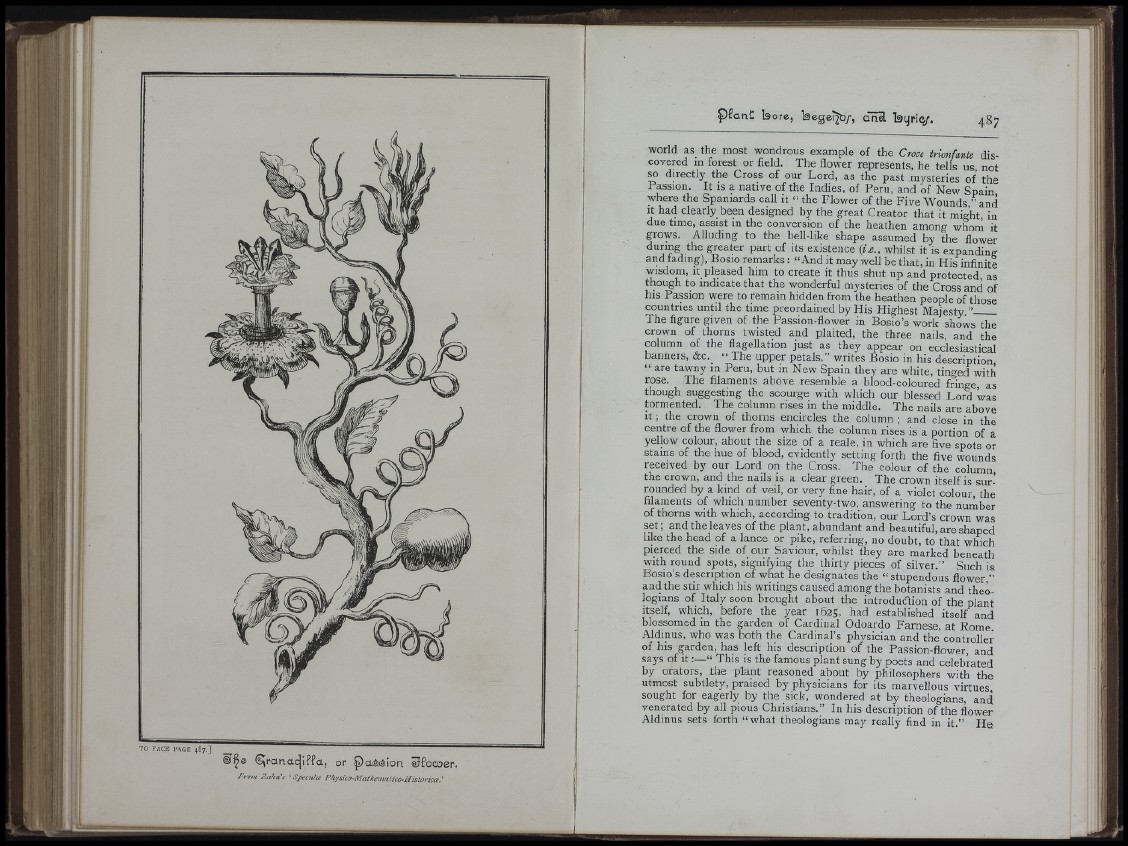
p l a n t b o r o , b e g c ] ^ / , a n i b q r ie /. 4 8 7
world as the most wondrous example of the Croce trionfante discovered
in forest or field. The fiower represents, he tells us not
so directly the Cross of our Lord, as the past mysteries of the
Passion. It IS a native of the Indies, of Peru, and of New Spain
where the Spaniards call it “ the Flower of the Five Wounds ’’ and
it had clearly been designed by the great Creator that it might in
due time, assist in the conversion of the heathen among whom it
grows. Alluding to the bell-like shape assumed by the fiower
dunng the greater part of its existence {i.e., whilst it is expandin©
and fading), Bosio remarks : “ And it may well be that, in His infinite
wisdom. It pleased him to create it thus shut up and protected as
though to indicate that the wonderful mysteries of the Cross and of
his Passion were to remain hidden from the heathen people of those
countries until the time preordained by His Highest Majesty ”____
The figure given of the Passion-fiower in Bosio’s work shows the
crown of thorns twisted and plaited, the three nails, and the
column of the fiagellation just as they appear on ecclesiastical
banners, &c. “ The upper petals,” writes Bosio in his description
“ are tawny in Peru, but in New Spain they are white, tinged with
rose. The filaments above resemble a blood-coloured fringe as
though suggesting the scourge with which our blessed Lord Was
tormented. The column rises in the middle. The nails are above
It ; the crown of thorns encircles the column ; and close in the
centre of the fiower from which the column rises is a portion of a
yellow colour, about the size of a reale, in which are five spots or
stains of the hue of blood, evidently setting forth the five wounds
received by our Lord on the Cross. The colour of the column
the crown, and the nails is a clear green. The crown itself is surrounded
by a kind of veil, or very fine hair, of a violet colour, the
filaments of which number seventy-two, answering to the number
of thorns with which, according to tradition, our Lord’s crown was
se t; and the leaves of the plant, abundant and beautiful, are shaped
like the head of a lance or pike, referring, no doubt, to that which
pierced the side of our Saviour, whilst they are marked beneath
with round spots, signifying the thirty pieces of silver.” Such is
Bosio’s description of what he designates the “ stupendous flower,’^
and the stir which his writings caused among the botanists and theologians
of Italy soon brought about the introdudfion of the plant
itself, which, before the year 1625, had established itself and
blossomed in the garden of Cardinal Odoardo Farnese, at Rome.
Aldinus, who was both the Cardinal’s physician and the controller
of his garden, has left his description of the Passion-flower, and
says of i t “ This is the famous plant sung by poets and celebrated
by orators, the plant reasoned about by philosophers with the
utmost subtlety, praised by physicians for its marvellous virtues
sought for eagerly by the sick, wondered at by theologians, and
venerated by all pious Christians.” In his description of the flower
Aldinus sets forth “ what theologians may really find in it.” He
II ' ^'J1
II ' i l
I
li
ife
Nil